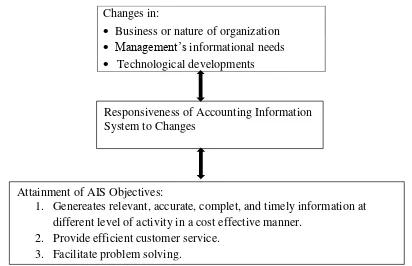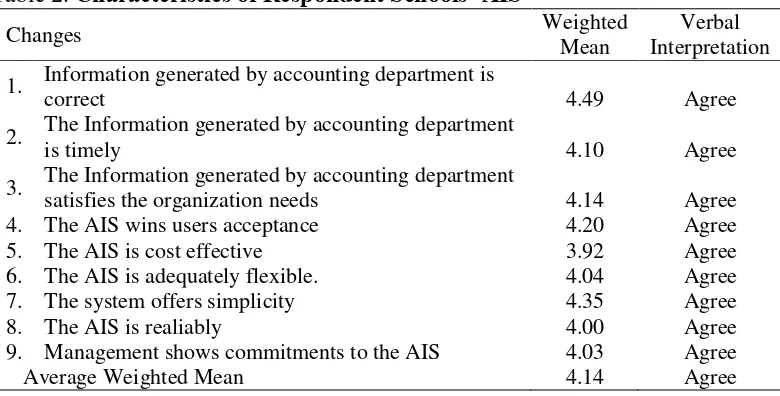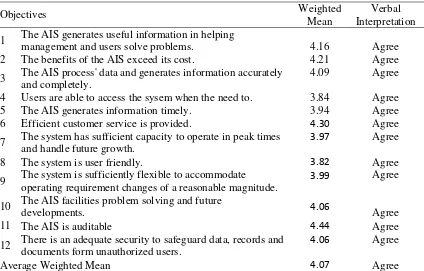Juni 2007, Vol. 6, No. 1, pp. 21-27
ACCOUNTING INFORMATION SYSTEM
OF THE SEVENTH-DAY ADVENTIST
SCHOOLS IN THE PHILIPPINES: A User’s
Perception
LeRoy Ruhupatty
Staff Pengajar Fakultas Ekonomi Universitas Klabat
This paper seeks to find out whether the Accounting Information System (AIS) of the Seventh-day Adventist (SDA) Church-owned and operated secondary schools in the Philippines have kept-up with changes in Inforamation Technology (IT), management’s information need,
and organization’s growth. –This paper also seeks to assess the system’s ability to meet its obejectives. It was found that the SDA secondary schools’ AIS is able to meet its obejctives, have
the chracteristics of a successful AIS, and is responsive to changes in IT, management’s
information need, and organization’s growth.
Intruduction
Individuals must make decisions throughout their lives, whether as members of families, groups and societies, or as employees and employers. Organizations are also faced with the same task, however, it is more complex because organizaitons are engaged in many activities that affects many parties.
At the early of the 21” century, developments in information Technology (IT) offer great advantage over a manual accounting system. Past studies that looked into the usefulness of computer technology found that accounting departements of some Philippine firms benefited from the use of computer in terms of efficiency, accuracy and timeliness. Furthermore, then studies found that increased productivity and improved customer services are some of the benefits expected from computerized system (Mitres & Chaya, 1996; Moran 1989). Regardless of all the benefits, accounting information can only be meaningful if analysed and interpreted correctly.
The subject of this study is the Sevent-day Adventist (SDA) Church-owned and Operated secondary schools in the Philippine. These schools are non-profit organizations, and just like other profit institutions, ther are faced with canges both internal and external to the organization. This study focuses on the characteristics and responsiveness of the respondent accounting Information Technology (AIS) to changes and its ability to meet obejctives.
Research Question and Hypothesis
This study sought to find out whether the AIS of the seventh-day Adventist Church-owned and operated Secondary schools have adapted to changes in IT, management’s informational need, and organization’s growth in terms of increase in number of student. This study also assess’ the system’s ability to meet objectives and, thus, its characteristics.
It is also expected that the responsiveness of respondent schools’s AIS
years the schools have been in operation, current manpower size, size of budget for accounting department, but not associated with current schools year enrolement Both hypotheses were tested in its nul form.
Related Literature
AIS is a collection of resource designed to transform financial and other data into information (Bodnar & Hopwood 1995). This information is then commucated to a wide variety of decision-maker. Organizations are continually faced with the need for new of better information because of the ever-changing nature of their environment, such as, changes in nature of business, nature of organization, needs of people, and technological development To meet this need and be responsive, organization’s information syatem must be periodically undergo changes that range from minor to major overhauls (Romney and Steinbart, 2003; Cushing & Romney, 1990).
As people gain expericne or take on new responsibilities, their information requirements often change; thus the information systemcan be greatly influenced by changes in user’s information nedds.
useful. However, there are still problems encounterd, such as delayed reports. Lack of technical know-how, errors in reports, high cost of allocation, and lack of accounting and managerial control (Abuel, 1996). For this reason, a system needs to be properly tailored to its environment and continuously undergo evaluation.
An according system is considered successful if it achieves four objectives: correct and timely information; meet organizations’ informational need; gain users’ satisfaction; and completed within a reasonable amount of time (Bookholdt & Li, 1991. An ideal accounting system should be able to process information efficiently,
producerelevant information on a timely basis, ensure relevant high degree of accuracy and minimize possibility of theft and fraud (Anthony & Reece, 1989). Some other critical success factors are cost effectiveness, flexilibility, simplicity, realiability, user’s acceptance and mangements’ commitement (Manuel, 1997; Nash & Heagy, 1993). These qualities are somewhat overlapping; however, they reflect the features of an ideal accounting system.
The interaction between AIS and its environment and how it affects the attainment of AIS objectives is presented in the following figure.
Figure 1. Interaction between AIS and changes an dteh attainment of its objectives
Research Design
Population and Sample. In 1998, Seventh-day Adventist Church owns and operates twenty-two (22) secondary schools in the Philippines. Thirteen (13) were included in this study because of the number of studentws. It is expected that the schools AIS will face more strain as the number of students increase.
Research Instrument.- The Closed-ended questionnaires were used in gathering
the respondents’ perception, white documentary analysis and unstructured interview was also used in obtaining relevant historical data, policies and organizational structure.
Statistical Tools. In quantifying and interpreting the responses rece 1% ed the
Responsiveness of Accounting Information System to Changes
Attainment of AIS Objectives:
1. Genereates relevant, accurate, complet, and timely information at different level of activity in a cost effective manner.
Table 1. Likert Scale Model Used to Quantify Respondents’ Response
The Kruskal. – Wallis test (H test) was used in testing for significant difference in the characteristics of schools’ AIS. Pearson Correlation was used to find any significant relationships between the responsiveness of respondet schools’ AIS and the number of years the schools has been in operation, current year enrolment, manpower size
current year budget for accounting department.
Findings
Characteristics of Respondents School’s AIS. Summary to the question and the responses received are presented in Table 2.
Table 2. Characteristics of Respondent Schools’ AIS
Changes Weighted
Mean
Verbal Interpretation
1. Information generated by accounting department is
correct 4.49 Agree
2. The Information generated by accounting department
is timely 4.10 Agree
3. The Information generated by accounting department
satisfies the organization needs 4.14 Agree
4. The AIS wins users acceptance 4.20 Agree
5. The AIS is cost effective 3.92 Agree
6. The AIS is adequately flexible. 4.04 Agree
7. The system offers simplicity 4.35 Agree
8. The AIS is realiably 4.00 Agree
9. Management shows commitments to the AIS 4.03 Agree
Average Weighted Mean 4.14 Agree
The responses ranges from a low of 3.92 to a high of 4.49, all are verbally interpreted as agree. The average weighted mean is 4.14, which means that the respondents agree.
The responses ranges from a low of 3.92 to a high 4.49 all are verbally interpreted as agree. The average weighted mean is 4.14, which means that the respondents agree that the schools’ AIS have the characteristics of successful AIS.
The characteristics of respondent schools’ AIS were then tested for significant differences when they are grouped according to number of years schools has benn in operation, degree of
there are no significant differences. All three calculated h-value is lesser than X2 value of 3.841 at a 1.05 and degree of Ereedom of one (2-1). This indicates that against expectations, both older and younger schools have similar AIS characteristics, schools with different level of computerization have similar AIS characteristics, and schools with large and small budgetary support for accounting department have similar AIS characteristics.
The respondents agreed that their school’s AIS are responsive enough to changes in IT, management’s information needs and growth in number of students. The summary of their respondents is Range Weight Interpretation
4.51 - 5.00 5 Strongly Angreed
3.51 - 4-50 4 Agree
2-51 - 3.50 3 Slightly Agree
1.51 - 2.50 2 Disagree
Table 3. Responsive of AIS to Changes
The respondent schools’ AIS are then related to the number of years the schools have been in operation, current schools year enrolment, current manpower size and
school year’s budget for accounting department. The test for significance in relationship is summarized in Table 4.
Table 4. Association between Responsiveness of Respondent Schools AIS with certain Variables
Variable r p Verbal Interpretation
1 Number of years schools have been in
operation -0.4 0.228 No Association
2 Current school year enrolment -0.45 0.017 Negative Association
3 Current school manpower size -0.64 0.132 No Association
4 Current school year's budget for accounting
departement 0.17 0.478 No Association
Ifp is lesser than a 0.05, there is a significant relationship
The r-value showed low negative relationship for the first three variables and low positive relationship forth fouth
variable. However, the relationship is not significant for the number of years the schools have been operating, the manpower size of the schools, and budgetary size for accounting department, indicating that the responsiveness of AIS is not associated with the length of years the schools have been in operation, manpower size of the
organization, and the size of budget for accounting department. Ideally, the longer the schools have been in operation, the more manpower the schools have, and the larger
budget accounting department has, the more responsive the AIS.
On the other hand, there is a low
negative and significant correlation between the responsiveness of schools’ AIS and the number enrolemnt, indicating that higher number of enromelment places more strain on the AIS and, thus, making it less
responsive.
In terms of attainment of objectives of schools AIS, the respondents also agreed that the schools’ AIS are able to meet its objectives (average weighted mean of 4.07). The questions and response are summarized in table 5.
Changes Weighted
Mean
Verbal Interpretation
1. Information Technology 4.11 Agree
2. Management Information Needs 3.99 Agree
3. Increase in Number of Students 4.11 Agree
Table 5. Attainment of AIS Objectives
Objectives Weighted
Mean
Verbal Interpretation
1 The AIS generates useful information in helping
management and users solve problems. 4.16 Agree
2 The benefits of the AIS exceed its cost. 4.21 Agree
3 The AIS process' data and generates information accurately
and completely.
4.09 Agree
4 Users are able to access the sysem when the need to. 3.84 Agree
5 The AIS generates information timely. 3.94 Agree
6 Efficient customer service is provided. 4.30 Agree
7 The system has sufficient capacity to operate in peak times
and handle future growth.
3.97 Agree
8 The system is user friendly. 3.82 Agree
9 The system is sufficiently flexible to accommodate
operating requirement changes of a reasonable magnitude.
3.99 Agree
10 The AIS facilities problem solving and future
developments. 4.06 Agree
11 The AIS is auditable 4.44 Agree
12 There is an adequate security to safeguard data, records and
documents form unauthorized users.
4.06 Agree
Average Weighted Mean 4.07 Agree
This study examines the perception of users of AIS_ The population are the SDA Chruch-owned and operated secondary schools in the Philippines 1998. The study sought to find out whether the respondent schools’ AIS has the charactistics of a successful AIS, how responsive it is to changes in organization or business nature, managements information need and IT. The study also sought to find out whether there are differences in the characteristics when the schools are grouped according to a variety of variables and whether there are significant relationship between the responsiveness of the AIS and a variety of variables. Furthermore, the study sought to find out whether the AIS meet its objectives. Generally the respondents agreed that the schools’ AIS have the characteristics of successful AIS. However, when grouped according to age of school, number of
students and budget for accounting department, there were no differences found in the characteristic of the schools AIS. This means that young and old schools, schools with small and larger budgetary support, and schools with low and high computerization have successful AIS.
References
AbLiet- M_ R. C. (1996). Computerized Information System of the Credit Guarantee Corporations. Unpublished MBA Thesis, University of Santo Thomas, Manila.
Anthony, R. N., and Reece, J. S. (1989). Accounting Texts and Cases. Homewood, Illinois: Richard D. Irwin, Inc.
Bodnar, G. H., and Hopwood, W. S. (1995). Accounting Information System (5th ed.). New Jersey: Prentice Hall, Inc.
Boockholdt, J. L., and Li, D. H. (1991). AIS. USA: Richard D. Irwin, Inc.
Cushing, B. E., and Romney, M. B. (1990). Accounting Information System (5th ed.). USA: Addison-Wesley Publishing Company, Inc.
Manuel, Z. v. C. (1997). Partnership and Corporation Accounting (7th ed.). Philippines: Zenaida Vera Cruz Manuel.
Mitra, S., and Chaya, A. K. (1996). Analyzing Cost Effectiveness of Organizations: The Impact of Information Technology Spending. Journal of Management Information System, 13 (2), 29-57.
Moran , A. (1989). Cybernetics as a Plus Factor to Accountig. Unpublished MSC Thesis, University of Santo Thomas, Manila.



